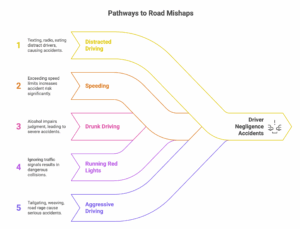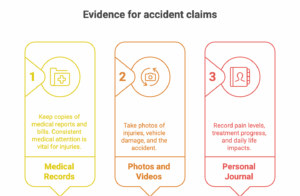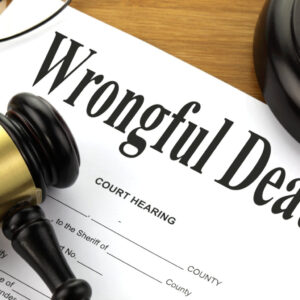So, you’ve been injured in a car accident. You know the other driver was at fault, but proving it can feel like a mountain to climb. Don’t worry. You’re not alone, and there are ways to build a strong case, even if the initial evidence seems weak. Let’s explore some unexpected avenues to help you prove driver negligence and get the compensation you deserve.
Driver Negligence Accident Injury: Understanding Your Rights
When a driver’s carelessness causes an accident, it’s considered negligence. This means they failed to act with the reasonable care a prudent person would under similar circumstances.

Examples of negligent driving behaviours include:
- Distracted driving: Texting while driving, fiddling with the radio, or even eating can take a driver’s attention off the road. According to the National Highway Traffic Safety Administration (NHTSA), distracted driving claimed 3,142 lives in 2020 alone.
- Speeding: Exceeding the posted speed limit or driving too fast for conditions is a common cause of accidents.
- Drunk driving: Driving under the influence of alcohol or drugs severely impairs judgment and reaction time.
- Running red lights or stop signs: Disregarding traffic signals is a blatant act of negligence.
- Aggressive driving: Tailgating, weaving through traffic, and road rage incidents can lead to serious accidents.
If a driver’s negligence resulted in your injuries, you have the right to seek compensation for your losses.
How a Personal Injury Lawyer Establishes Driver Negligence After an Accident
A personal injury lawyer specialises in accident cases and knows how to build a solid case against the negligent driver. Your lawyer’s role is to prove:
- Duty of care: The driver had a responsibility to operate their vehicle safely.
- Breach of duty: The driver violated that responsibility through negligent actions.
- Causation: The driver’s negligence directly caused the accident.
- Damages: You suffered actual losses as a result of the accident (medical bills, lost wages, pain and suffering, etc.).
Beyond Police Reports: 3 Unexpected Sources of Evidence in Driver Negligence Accident Cases
While a police report is a valuable piece of evidence, it’s not the only thing. Think outside the box:
- Social Media Posts: A driver bragging about speeding on social media or posting about a party right before the accident, can be powerful evidence.
- Vehicle Data Recorders (Black Boxes): Many modern vehicles have “black boxes” that record data like speed, braking, and impact force. This data can reveal critical information about the moments leading up to the crash.
- Nearby Surveillance Footage: Businesses or homes near the accident scene may have security cameras that captured the event.
The Power of Expert Testimony: Reconstructing the Accident to Prove Driver Fault
Sometimes, you need an expert to help explain the accident. Accident reconstruction experts can analyse the evidence and provide their professional opinion on how the accident occurred. Their testimony can be crucial in demonstrating the driver’s fault, particularly in complex cases.
Documenting Your Injuries
Detailed documentation is key to a successful claim. This includes:

- Medical Records: Keep copies of all medical reports, bills, and therapy records. For example, injuries like whiplash can take time to fully manifest, so consistent medical attention is vital. Spinal injuries can require extensive, ongoing care.
- Photos and Videos: Take photos of your injuries, the damage to your vehicle, and the accident scene.
- Personal Journal: Record your pain levels, treatment progress, and how the injuries impact your daily life.
Connecting Driver Negligence to Your Injuries: Proving Causation for a Stronger Case
You must show a direct link between the driver’s negligence and your injuries. For example, if you suffered a back injury, you need to demonstrate that the impact from the accident caused the injury. Medical expert testimony can be invaluable in establishing this connection.
Negotiation and Litigation: What to Expect When Pursuing a Driver Negligence Accident Injury Claim
Your attorney will negotiate with the at-fault driver’s insurance company to reach a settlement. This involves presenting evidence of negligence, your injuries, and damages. If negotiations fail, your lawyer can file a lawsuit to pursue your claim in court.
Types of Damages Recoverable
You may be entitled to compensation for:
- Medical Expenses: Past and future medical bills.
- Lost Wages: Income lost due to your injuries.
- Pain and Suffering: Compensation for the physical and emotional distress caused by your injuries.
- Property Damage: Repair or replacement of your damaged vehicle.
- Diminished Value: Compensation for the decrease in your vehicle’s value after being repaired.
- Loss of Consortium: In some cases, your spouse may be able to recover damages for the loss of companionship and support.
Negotiating with Insurance Companies
Insurance companies often try to minimise payouts. Your attorney will advocate for your best interests and ensure you receive fair compensation. They’ll handle all communication with the insurance company and protect you from being taken advantage of.
Alternative Dispute Resolution (ADR)
Mediation is a common form of ADR where a neutral third party helps you and the insurance company reach a settlement. This can be a faster and less expensive alternative to going to trial.
Uninsured/Underinsured Motorist Coverage
If the at-fault driver is uninsured or underinsured, your own insurance policy may provide coverage for your injuries. Your attorney can help you navigate this process and ensure you receive the maximum benefits available.
By understanding your rights, gathering evidence, and working with an experienced personal injury lawyer, you can significantly increase your chances of proving driver negligence and recovering the compensation you deserve.





